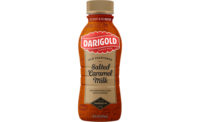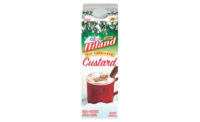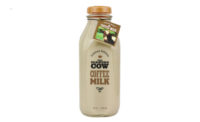Milk processors use flavors, processing techniques and packaging to make their beverages stand out in the dairy case. But the battle for market share and share of stomach is not fought solely in the grocery store. Savvy marketers are placing their products in alternative channels such as health clubs, home improvement stores and outdoor equipment retailers.
Upstate Farms, Buffalo, N.Y., is selling its Crave flavored milks in Dick’s Sporting Goods stores and Home Depot. Upstate identified active young males and construction workers as key consumers of chocolate milk, says Ken Voelker, director of marketing. It developed a self-service cooler for extended shelf life, so that retailers can position the milk in the checkout aisle. Crave is packaged in resealable aluminum pint bottles.
Nestlé also identified the hard hat wearer, and the 18- to 35-year-old male in general, as an important demographic for its Nesquik chocolate milk, says Chip Marks, a marketing associate in the company’s Glendale, Calif., headquarters. The beverage is consumed across all dayparts, he says, including breakfast, as a snack and in the evening. At the NACS tradeshow for convenience store retailers in October, Nestlé promoted its new 8-ounce bottles of strawberry and chocolate low-fat milks, which will be available in February 2012.
A Nesquik sales sheet encourages retailers to “think outside the cooler” by placing aseptic packages of the beverage near pastries, cold sandwiches and fruit. The company cited information from Dairy Management Inc., Rosemont, Ill., showing that when Nesquik was placed in a secondary location, it generated additional sales of 40%.
Chocolate milk is also a favorite of children who buy it in schools. The added sugars have proven to be a lightening rod, attracting activist parents who seek to ban flavored milk from school cafeterias. Chef and nutrition gadfly Jamie Oliver used his ABC television show, “Jamie Oliver’s Food Revolution,” to force the Los Angeles Unified School District to toss flavored milk off the menu.
Dean Foods Co., Dallas, one of the leading school milk providers in the nation, developed chocolate- and strawberry-flavored non-fat milks for school foodservice under the name TruMoo. (Dean Foods has a low-fat version for retail sale.)
“We’re proud to offer a fat-free flavored milk that meets the proposed USDA school meal guidelines a full year in advance of their anticipated implementation,” says Rick Zuroweste, Dean’s chief marketing officer. “Our school customers see the future, and we’re offering them a solution today. As a result, many of our school customers converted to the fat-free TruMoo at the start of this 2011-12 school year.”
“In regards to flavored milk, the consumer patterns continually shift between concern over calories, concern about grams of total sugar and concern about high-fructose corn syrup. Our research and development group did an excellent job of navigating the shifting sands in developing TruMoo, a product that addressed several consumer preferences while keeping taste priority No. 1,” Zuroweste says.
Some milk processors have dropped high-fructose corn syrup (HFCS) from their formulas, and tout that on their packaging. The stance of corn syrup providers is that “a sugar is a sugar,” and that compositionally, table sugar and corn sugar are nearly identical, and that nutritionally, the two ingredients are the same.
Last summer, Prairie Farms Dairy removed HFCS in its flavored milks for schools. The dairy cooperative, headquartered in Carlinville, Ill., offers chocolate, strawberry, vanilla and cookies and cream flavors. An 8-ounce serving of the reformulated fat-free milk has 130 calories and 11 grams of added sugar. The previous 1% formula had 170 calories and 16 grams of added sugar.
Dean’s Zuroweste says the company’s focus in 2011 “has been innovating across our businesses in 2011, including our plant-based Silk product line, Horizon Organic and conventional milk categories.”
He calls the national launch of TruMoo flavored milk “a potential game changer for the dairy industry. Consumers have been calling for a better-for-you flavored milk, and TruMoo delivers on a scale unseen in the dairy case.”
Adding flavor is one way to differentiate milk; processing is another. Dean’s WhiteWave Foods division is testing a fine-filtered milk called Simply Pure that is sold in half gallons in fat-free, reduced-fat and whole options.
“We believe, and our research suggests, that about a third of conventional milk purchasers are looking for something new and different in their milk choices. Simply Pure meets this demand with the extra step of fine filtering to remove more of the impurities left behind in conventional milk,” says Sara Loveday, senior communications manager for the Broomfield, Colo.-based company.
Before pasteurization, WhiteWave passes milk through a very fine filter to physically remove some of the impurities.
“Because we’ve taken care to create just the right degree of filtration, certain impurities are removed, but the protein, calcium and vitamins you count on from milk remain. Our fine filter traps and removes coarse natural impurities such as non-nutritional matter and cellular material, including many of the somatic cells found in unprocessed milk,” Loveday says.
Loveday says the company does not claim that Simply Pure tastes better or is fresher than conventional milk.
Another way to differentiate one milk from another is to add probiotics. In June, Foster Farms Dairy, Modesto, Calif., launched Dairy Balance, sold in whole and 2% varieties.
“Probiotics are ‘good bacteria’ that have been shown to improve digestive health and support immunity,” says company president Jeff Foster. “Sales of yogurt enhanced with probiotics have dramatically grown, and studies have proven Dairy Balance delivers more active cultures than yogurt.”
Processors of organic milk have been able to distinguish their beverages from conventional milk while receiving a premium. The price of a gallon of organic milk can be double that of conventional milk.
“In the organic dairy category, we’ve seen growing consumer interest in fortified organic dairy products,” says Loveday. Horizon is WhiteWave’s brand of organic milk brand. “Our largest growth in this area has been with our omega-3 DHA organic milk products.”
Earlier this year, Horizon launched a fat-free, plant-based omega-3 DHA organic milk.
Organic Valley, La Farge, Wis., also markets a line of milks fortified with the omega-3 fatty acids DHA and EPA. The switch to organic milk from conventional milk is often triggered by a change in lifestyle, says Tripp Hughes, the company’s director of category management. Triggers include having children, a desire to eat better foods because of a health problem and a general interest in health and wellness.
While sales of organic milk increased 12.2% from 2009 to 2010, the product makes up just 3.3% of total milk sales, according to the Milk Processor Education Program (MilkPEP), which helps processors develop marketing messages. The milk industry is not going to grow on organic sales alone.
In 2012, the Washington, D.C.-based organization is making “fewer but bigger bets” in its messages, says MilkPEP CEO Vivien P. Godfrey. First, milk processors must “defend breakfast” as the important milk-drinking occasion of the day. Second, processors will promote chocolate milk as a recovery beverage to replace sports drinks. The so-called Breakfast Project has the message “Every good day starts with milk.” The audience for the Refuel with Chocolate Milk message is the active 18- to 34-year-old adult who works out hard and participates in triathlons, marathons or other extreme sports.
If MilkPEP is successful, this young cohort will develop a favorable attitude toward chocolate milk. This will carry over as they begin to start families, so that when their children enter school, flavored milk won’t be the bugbear it is now. Then processors will truly savor the flavor of increased milk sales.
|
Milk Processors Are Talking About
Milk’s Bold Message: An Irreplaceable Package of Nutrients
Drink Up, Baby Boomers
New consumer research based on the Kantar report shows that milk’s offerings are out of sync with what the powerful group of 50-plus purchasers is looking for in a beverage: satisfying thirst, accompanying food and providing fun or a treat. (Currently, tap water and carbonated soft drinks dominate the food accompaniment state, and competition is fierce with carbonated soft drinks, coffee and tea for the fun/treat state.) Functional beverages also present a promising opportunity among this consumer segment. Madlyn Daley is the senior vice president, strategic insights, dairy, at the Innovation Center for U.S. Dairy, Rosemont, Ill. |











